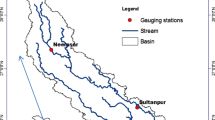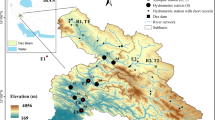Abstract
The co-variation of rainfall and flow was assessed in four selected catchments of the River Nile which has two main sources including the White Nile (in the Equatorial region) and the Blue Nile (from the Ethiopian highlands). The selected catchments included Kyoga and Kagera (from the Equatorial region), as well as Blue Nile and Atbara (in Sudan and Ethiopia). In each catchment, the flow-rainfall co-variation was investigated at both seasonal and annual time scales. To explain aggregated variation at larger temporal scale while investigating the possible change in catchment behavior, which may interfere with the flow-rainfall relationship, rainfall-runoff modeling was done at daily time scale using data (falling within the period 1949–2003) from Kagera and Blue Nile i.e. the major catchment of each region where the River Nile emanates. Correlation analysis was conducted to assess how well the variation of flow and that of catchment-wide rainfall resonate. The co-occurrence of the changes in observed and simulated overland flow was examined using the quantile perturbation method (QPM). Trends in the model residuals were detected using the Mann–Kendal (MK) and cumulative rank difference (CRD) tests. The null hypothesis H 0 (no correlation between rainfall and flow) was rejected at the significance level α of 5% for all the selected catchments. The temporal changes in terms of the QPM anomalies for both the observed and simulated flow were in a close agreement. The evidence to reject the H 0 (no trend in the model residuals) was generally statistically insufficient at α = 5% for all the models and selected catchments considering both the MK and CRD tests. These results indicate that change in catchment behavior due to anthropogenic influence in the Nile basin over the selected time period was minimal. Thus, the overall rainfall-runoff generation processes of the catchments did not change in a significant way over the selected data period. The temporal flow variation could be attributed mainly to the rainfall variation.





Similar content being viewed by others
References
Abtew W, Melesse AM, Dessalegne T (2009) El Niño Southern Oscillation link to the Blue Nile River basin hydrology. Hydrol Process 23:3653–3660
AghaKouchak A, Habib E (2010) Application of a conceptual hydrologic model in teaching hydrologic processes. Int J Eng Educ 26(4):963–973
AghaKouchak A, Nakhjiri N, Habib E (2013) An educational model for ensemble streamflow simulation and uncertainty analysis. Hydrol Earth Syst Sci 17:445–452
Allen RG, Pereira LS, Raes D, Smith M (1998) Crop evapotranspiration—guidelines for computing crop water requirements—FAO Irrigation and Drainage Paper 56, ISBN 92-5-104219-5. FAO—Food and Agriculture Organization of the United Nations, Rome
Bergström S (1976) Development and application of a conceptual runoff model for Scandinavian catchments. SMHI RHO 7, Norrköping
Beven KJ, Binley AM (1992) The future role of distributed models: model calibration and predictive uncertainty. Hydrol Process 6:279–298
Bewket W, Sterk G (2005) Dynamics in land cover and its effect on stream flow in the Chemoga watershed, Blue Nile basin, Ethiopia. Hydrol Process 19:445–458
Box GEP, Cox DR (1964) An analysis of transformations. J R Stat Soc 26:211–243
Camberlin P (1997) Rainfall anomalies in the source region of the Nile and their connection with the Indian summer monsoon. J Clim 10:1380–1392
Camberlin P (2009) Nile basin climates. In: Dumont HJ (ed) The Nile: origin, environments, limnology and human use, monographiae biologicae, vol 89. Springer, Dordrecht, pp 307–333
DHI (2007) MIKE11—a modeling system for rivers and channels. Reference manual, DHI Water & Environment, Hørsholm, pp 278–325
Di Matteo T (2007) Multi-scaling in finance. Quant Financ 7(1):21–36
Elmqvist B (2005) Land use assessment in the drylands of Sudan using historical and recent high resolution satellite data. In: The 31st international symposium on remote sensing of the environment, Jun 2004; St. Petersburg, ISRSE
FAO (1997) Irrigation potential in Africa: a basin approach, M-54. FAO Land and Water Bull, Rome
Gebrehiwot SG, Seibert J, Gärdenäs AI, Mellander PE, Bishop K (2013) Hydrological change detection using modeling: half a century of runoff from four rivers in the Blue Nile Basin. Water Resour Res 49:3842–3851
Harrigan S, Murphy C, Hall J, Wilby RL, Sweeney J (2014) Attribution of detected changes in streamflow using multiple working hypotheses. Hydrol Earth Syst Sci 18:1935–1952
Hoell A et al (2015) The forcing of monthly precipitation variability over Southwest Asia during the Boreal Cold Season. J Clim 28(18):7038–7056
Kalnay E et al (1996) The NCEP/NCAR 40-year reanalysis project. Bull Am Meteorol Soc 77(3):437–471
Kendall MG (1975) Rank correlation methods, 4th edn. Charles Griffin, London
Kennedy & Donkin Power Ltd in Association with Sir Alexander Gibb & Partners and Kananura Melvin Consulting Engineers (1997) Hydropower development plan part 1 (final report)—volume 8, and environmental impact assessment (stage 1)—volume 8, Uganda Electricity Board, Kampala
Legesse D, Vallet-Coulomba C, Gasse F (2003) Hydrological response of a catchment to climate and land use changes in Tropical Africa: case study South Central Ethiopia. J Hydrol 275:67–85
Legesse D, Vallet-Coulomb C, Gasse F (2004) Analysis of the hydrological response of a tropical terminal lake, Lake Abiyata (Main Ethiopian Rift Valley) to changes in climate and human activities. Hydrol Process 18:487–504
Madsen H (2000) Automatic calibration of a conceptual rainfall-runoff model using multiple objectives. J Hydrol 235:276–288
Mandelbrot B (1965) Une classe de processus stochastiques homothetiques a soi: application a la loi climatologique de H.E. Hurst. C R Acad Sci 260:3274–3276
Mango LM, Melesse AM, McClain ME, Gann D, Setegn SG (2011) Land use and climate change impacts on the hydrology of the upper Mara River Basin, Kenya: results of a modeling study to support better resource management. Hydrol Earth Syst Sci 15:2245–2258
Mann HB (1945) Nonparametric tests against trend. Econometrica 13(3):245–259
Merz B, Vorogushyn S, Uhlemann S, Delgado J, Hundecha Y (2012) HESS opinions “more efforts and scientific rigour are needed to attribute trends in flood time series”. Hydrol Earth Syst Sci 16:1379–1387
Nash JE, Sutcliffe JV (1970) River flow forecasting through conceptual models part I—a discussion of principles. J Hydrol 10:282–290
Nicholson SE (1996) A review of climate dynamics and climate variability in Eastern Africa. In: Johnson TC, Odada EO (eds) The limnology, climatology and paleoclimatology of the East African Lakes. Gordon and Breach, Amsterdam, pp 25–56
Ntegeka V, Willems P (2008) Trends and multidecadal oscillations in rainfall extremes, based on a more than 100 year time series of 10 min rainfall intensities at Uccle, Belgium. Water Resour Res 44:W07402. doi:10.1029/2007WR006471
Olang LO, Fürst J (2011) Effects of land cover change on flood peak discharges and runoff volumes: model estimates for the Nyando River Basin, Kenya. Hydrol Process 25:80–89
Onyutha C (2016a) Influence of hydrological model selection on simulation of moderate and extreme flow events: a case study of the Blue Nile basin. Adv Meteorol 1–28. Article ID 7148326. doi:10.1155/2016/7148326
Onyutha C (2016b) Identification of sub-trends from hydro-meteorological series. Stoch Environ Res Risk Assess 30:189–205
Onyutha C (2016c) Statistical uncertainty in hydrometeorological trend analyses. Adv Meteorol 1–26. Article ID 8701617. doi:10.1155/2016/8701617
Onyutha C (2016d) Statistical analyses of potential evapotranspiration changes over the period 1930–2012 in the Nile River riparian countries. Agric For Meteorol 226–227:80–95
Onyutha C, Willems P (2015a) Empirical statistical characterization and regionalization of amplitude-duration-frequency curves for extreme peak flow in the Lake Victoria Basin, East Africa. Hydrol Sci J 60(6):997–1012
Onyutha C, Willems P (2015b) Spatial and temporal variability of rainfall in the Nile Basin. Hydrol Earth Syst Sci 19:2227–2246
Onyutha C, Willems P (2015c) Uncertainty in calibrating generalised Pareto distribution to rainfall extremes in Lake Victoria Basin. Hydrol Res 46(3):356–376
Rientjes THM, Haile AT, Kebede E, Mannaerts CMM, Habib E, Steenhuis TS (2011) Changes in land cover, rainfall and stream flow in Upper Gilgel Abbay catchment, Blue Nile basin—Ethiopia. Hydrol Earth Syst Sci 15:1979–1989
Sheffield J, Goteti G, Wood EF (2006) Development of a 50-year high-resolution global dataset of meteorological forcings for land surface modeling. J Clim 19(13):3088–3111
Siam MS, Eltahir EAB (2015) Explaining and forecasting interannual variability in the flow of the Nile River. Hydrol Earth Syst Sci 19:1181–1192
Solomatine DP, Shrestha DL (2009) A novel method to estimate model uncertainty using machine learning techniques. Water Resour Res 45:W00B11. doi:10.1029/2008WR006839
Staudinger M, Stahl K, Seibert J, Clark MP, Tallaksen LM (2011) Comparison of hydrological model structures based on recession and low flow simulations. Hydrol Earth Syst Sci 15:3447–3459
Taye MT, Willems P (2013) Identifying sources of temporal variability in hydrological extremes of the upper Blue Nile basin. J Hydrol 499:61–70
Tierney JE, Smerdon JE, Anchukaitis KJ, Seager R (2013) Multidecadal variability in East African hydroclimate controlled by the Indian Ocean. Nature 493:389–392
Willems P (2009) A time series tool to support the multi-criteria performance evaluation of rainfall-runoff models. Environ Model Softw 24:311–321
Willems P (2013) Multidecadal oscillatory behaviour of rainfall extremes in Europe. Clim Change 120:931–944
Willems P (2014) Parsimonious rainfall-runoff model construction supported by time series processing and validation of hydrological extremes—part 1: step-wise model-structure identification and calibration approach. J Hydrol 510:578–590
Willems P, Mora D, Vansteenkiste T, Taye MT, Van Steenbergen N (2014) Parsimonious rainfall-runoff model construction supported by time series processing and validation of hydrological extremes—part 2: intercomparison of models and calibration approaches. J Hydrol 510:591–609
Yue S, Wang C (2004) The Mann–Kendall test modified by effective sample size to detect trend in serially correlated hydrological series. Water Resour Manage 18:201–218
Zeng R, Cai X (2016) Climatic and terrestrial storage control on evapotranspiration temporal variability: analysis of river basins around the world. Geophys Res Lett 43:185–195
Acknowledgements
The research was financially supported by an IRO Ph.D. scholarship of KU Leuven.
Author information
Authors and Affiliations
Corresponding author
Electronic supplementary material
Below is the link to the electronic supplementary material.
Rights and permissions
About this article
Cite this article
Onyutha, C., Willems, P. Investigation of flow-rainfall co-variation for catchments selected based on the two main sources of River Nile. Stoch Environ Res Risk Assess 32, 623–641 (2018). https://doi.org/10.1007/s00477-017-1397-9
Published:
Issue Date:
DOI: https://doi.org/10.1007/s00477-017-1397-9





